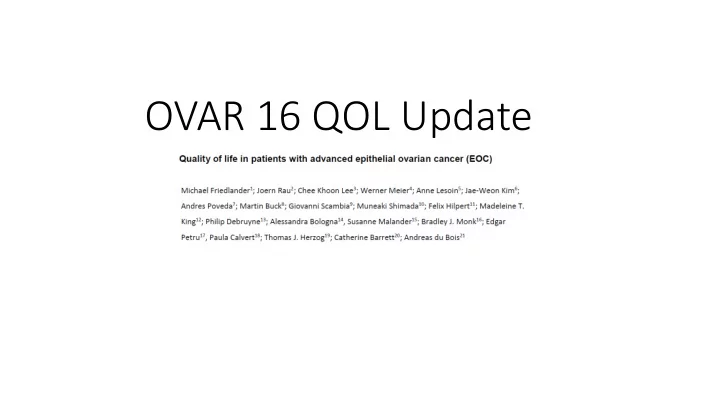

OVAR 16 QOL Update
Health-Related Quality of Life Secondary endpoint: evaluate health-related quality of life (HRQOL) as measured by EORTC QLQ-C30, OV28 and EQ-5D (captures health status across five dimensions: mobility, self-care, usual activities, pain/discomfort, anxiety/depression) • Data were collected at baseline, week 13, months 7, 10, 13, 16, 25 (end of treatment), and 31 (post-treatment) Pre-specified analyses examined HRQOL differences while on treatment Mixed-model repeated measures analysis
Exploratory Hypotheses Maintenance therapy with pazopanib will result in a small but statistically significant decline in global HRQOL and more side effects during the time on treatment, but will be associated with an overall benefit to patients Specifically: Pazopanib will be associated with superior quality adjusted PFS Progressive disease results in a decline in quality of life Pazopanib will delay the time to second line therapy
Proportion of EQ-5D Questionnaires Completed Progression-free (PF) Population Intent-to-treat (ITT) Population 99% 98% 99% 98% 98% 98% 100% 100 100 94% 90 90 84% 80 80 74% % of ITT Population % of PF Population 70 70 57% 60 60 50 47% 50 40 36% 40 30 30 24% 20 20 10 10 0 0 BL Wk13 M7 M10 M13 M16 M25 BL Wk13 M7 M10 M13 M16 M25 Study Visit Study Visit on treatment off treatment PF on treatment PF off treatment PP Abbreviations: BL, baseline; M, month; PP, post-progression; Wk, week.
Prespecified Analyses per Protocol Difference in change from baseline in HRQOL scores between treatment groups* QLQ-C30 Global Health Status OV-28 subscales EQ-5D *Mixed model repeated measure analysis Interpretation of clinical significance followed Cocks et al 2011 and Pickard et al 2007
QLQ-C30 Global Health Status 30 Pazopanib Placebo 20 Adjusted Mean ( ± SE) Better Health Status 10 0 -10 -20 -30 Baseline W13 M7 M10 M13 M16 M25 Abbreviations: M, month; SE, standard error of the mean; W, week.
EQ-5D Utility Index 0.3 Pazopanib Placebo 0.2 Adjusted Mean ( ± SE) 0.1 Better Utility 0 -0.1 -0.2 -0.3 Baseline W13 M7 M10 M13 M16 M25 Abbreviations: M, month; SE, standard error of the mean; W, week.
QLQ-C30 Diarrhea (ITT) 30 Pazopanib Placebo 20 Adjusted Mean ( ± SE) 10 More Diarrhea 0 -10 -20 -30 Baseline W13 M7 M10 M13 M16 M25 Abbreviations: ITT, intention-to-treat; M, month; SE, standard error of the mean; W, week.
Post Hoc / Exploratory Analyses Evaluate the trade-offs between treatment efficacy and treatment-related toxicity
Quality-Adjusted PFS (QAPFS) Therapy 1.0 Proportion Progression-Free 0.9 Pazopanib: QAPFS 0.8 Placebo: QAPFS 0.7 0.6 Median 0.5 0.4 0.3 0.2 P = 0.052 0.1 (1000 x bootstrap with replacement) 0.0 0 40 80 120 160 200 240 280 320 360 400 440 480 520 560 600 640 680 720 760 Days From Randomization
Post Hoc Analysis QLQ-C30 after progression QLQ-C30 Global Health Status (GHS) deteriorates with progression 8.6 points difference between pre- and post-progression ( P < 0.0001)* *paired t-test; analysis included patients with pre- and post-progression data pooled across treatment arms (N= 206 )
Post Hoc Analysis Time to Subsequent Anticancer Therapy 1.0 HR (95% CI): 0.722 (0.698, 0.858) Log-rank P value=0.0001 Proportion Progression-Free Pazopanib (n=472) 0.8 Placebo (n=468) 0.6 0.4 0.2 Medians 19.7 vs 15.0 months for pazopanib and placebo, respectively Curves divergent at 24 months 0.0 0 6 12 18 24 30 36 Time Since Randomization, Months Patients at risk Pazopanib 472 389 273 211 139 25 36 Placebo 468 384 253 195 133 32 3
Conclusions Maintenance therapy with pazopanib results in an improvement in median PFS of 5.6 months a small decrement in overall HRQOL for patients on treatment a significant increase in patient-reported diarrhea Progression results in worse HRQOL and initiation of further chemotherapy Quality-adjusted PFS supports the net value of maintenance therapy Limitations of post-hoc analyses highlight the importance of including a priori HRQOL hypotheses in future studies
Recommend
More recommend